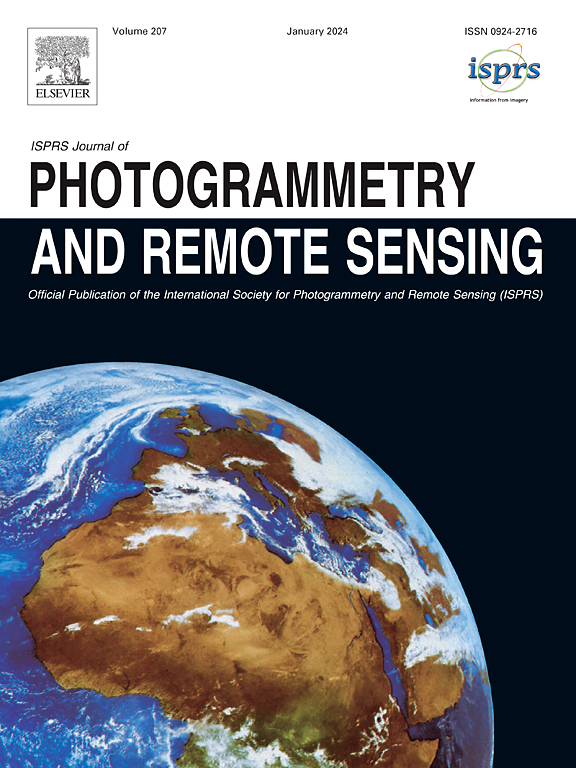Identify and track white flower and leaf phenology of deciduous broadleaf trees in spring with time series PlanetScope images
IF 10.6
1区 地球科学
Q1 GEOGRAPHY, PHYSICAL
ISPRS Journal of Photogrammetry and Remote Sensing
Pub Date : 2025-05-19
DOI:10.1016/j.isprsjprs.2025.05.013
引用次数: 0
Abstract
In spring, many deciduous broadleaf trees start with flower emergence and then leaf emergence, which are two key phenological events, as they signal the onset of reproduction and vegetative growth in a year. These trees provide essential resources for early pollinators searching for flowers, contribute to biodiversity, and create socio-economic benefits through tourism. Accurate detection and monitoring of the flower and leaf phenology of these trees are important. In this study we combine in-situ photo observations with time series satellite data in spring 2024 to develop new methods for identifying and tracking white flower and leaf phenology of Callery Pear trees, which are deciduous broadleaf trees distributed worldwide. We analyzed in-situ photos and surface reflectance, flower-related, and leaf-related vegetation indices from three optical satellite datasets—PlanetScope (3-m, daily), Sentinel-2 A/B (10-m, 5-day), and Harmonized Landsat and Sentinel-2 (HLS, 30-m, 2–3-day; HLSL30 and HLSS30). Time series of White Flower Index (WFI), a combination of blue, green, and red bands, delineated the flowering period (start, peak, and end dates) of white (light-colored) flowers. Time series of chlorophyll and green leaf indicator (CGLI; Blue < Green > Red) delineated the green leaf emergence dates of the trees (start of season, SOS). In comparison, flower and leaf phenology of these trees cannot be accurately identified and tracked by Sentinel-2 data due to insufficient number of good-quality observations and HLS data due to mixed land cover types in 30-m pixels. This study enhances our understanding of surface reflectance dynamics of flowers and green leaves of these trees in spring and demonstrates the critical role of satellite data with high spatio-temporal resolutions and WFI and CGLI algorithms in tracking floral and leaf phenology.
利用PlanetScope时间序列图像识别和跟踪春季落叶阔叶树白花叶物候
在春天,许多落叶阔叶树开始开花,然后出叶,这是两个关键的物候事件,因为它们标志着一年中繁殖和营养生长的开始。这些树木为寻找花朵的早期传粉者提供了必要的资源,促进了生物多样性,并通过旅游创造了社会经济效益。准确的检测和监测这些树木的花叶物候是很重要的。本文将2024年春季的原位照片观测与时间序列卫星数据相结合,建立了分布在世界各地的落叶阔叶树库勒里梨树白花叶物候识别与跟踪的新方法。利用planetscope (3-m,每日)、Sentinel-2 A/B (10-m, 5天)和Harmonized Landsat and Sentinel-2 (HLS, 30-m, 2 - 3天)三个光学卫星数据集分析了原位照片和地表反射率、花相关和叶相关植被指数;HLSL30和HLSS30)。白花指数(White Flower Index, WFI)的时间序列,由蓝、绿、红三个波段组合而成,描绘了白色(浅色)花的开花时间(开始、高峰和结束日期)。叶绿素和绿叶指数(CGLI)时间序列;蓝色& lt;绿色比;红色)描绘了树木的绿叶出现日期(季节开始,SOS)。相比之下,由于Sentinel-2数据的高质量观测数量不足,以及HLS数据在3000 m像素的混合土地覆盖类型,无法准确识别和跟踪这些树木的花叶物候。该研究增强了我们对这些树木春季花和绿叶表面反射率动态的认识,并证明了高时空分辨率的卫星数据以及WFI和CGLI算法在跟踪花和叶子物候方面的关键作用。
本文章由计算机程序翻译,如有差异,请以英文原文为准。
求助全文
约1分钟内获得全文
求助全文
来源期刊

ISPRS Journal of Photogrammetry and Remote Sensing
工程技术-成像科学与照相技术
CiteScore
21.00
自引率
6.30%
发文量
273
审稿时长
40 days
期刊介绍:
The ISPRS Journal of Photogrammetry and Remote Sensing (P&RS) serves as the official journal of the International Society for Photogrammetry and Remote Sensing (ISPRS). It acts as a platform for scientists and professionals worldwide who are involved in various disciplines that utilize photogrammetry, remote sensing, spatial information systems, computer vision, and related fields. The journal aims to facilitate communication and dissemination of advancements in these disciplines, while also acting as a comprehensive source of reference and archive.
P&RS endeavors to publish high-quality, peer-reviewed research papers that are preferably original and have not been published before. These papers can cover scientific/research, technological development, or application/practical aspects. Additionally, the journal welcomes papers that are based on presentations from ISPRS meetings, as long as they are considered significant contributions to the aforementioned fields.
In particular, P&RS encourages the submission of papers that are of broad scientific interest, showcase innovative applications (especially in emerging fields), have an interdisciplinary focus, discuss topics that have received limited attention in P&RS or related journals, or explore new directions in scientific or professional realms. It is preferred that theoretical papers include practical applications, while papers focusing on systems and applications should include a theoretical background.
 求助内容:
求助内容: 应助结果提醒方式:
应助结果提醒方式:


